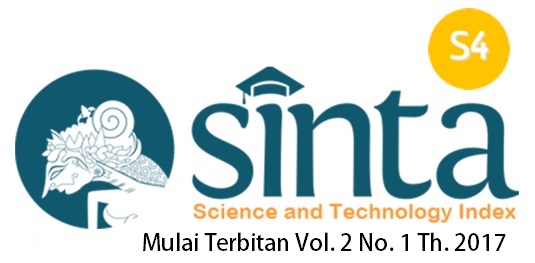Hubungan Kausal Antar Faktor-Faktor yang Mempengaruhi Sistem Informasi Akademik pada Perguruan Tinggi (Studi Kasus pada Perguruan Tinggi Swasta di Jawa Tengah)
Abstract
Keywords
Full Text:
PDFReferences
D. Ahmad Jakaria, R. Teduh Dirgahayu, and Hendrik, “Manajemen Risiko Sistem Informasi Akademik pada Perguruan Tinggi Menggunakan Metoda Octave Allegro,” Semin. Nas. Apl. Teknol. Inf., vol. 37, pp. 1907–5022, 2013.
N. U. Handayani, M. A. Wibowo, D. P. Sari, and Y. Satria, “Penilaian Risiko Sistem Informasi Fakultas Teknik Universitas Diponegoro Menggunakan Metode Failure Mode Effect And Analysis Berbasis Framework ISO 27001,” vol. 39, no. 2, pp. 78–85, 2018.
B. Rahardjo, Berbasis Internet, vol. 0. 2002.
R. Rahmadi, P. Groot, and T. O. M. Heskes, “Stable Specification Search in Structural Equation Models with Latent Variables,” ACM Trans, Intell. Syst. Technol, vol. 10, no. 5, 2019.
R. Rahmadi, Finding Stable Causal Structures From Clinical Data. Enschede: Gildeprint, 2019.
Ucu Nugraha, “Manajemen Risiko Sistem Informasi Pada Perguruan Perguruan Tinggi Menggunakan Kerangka Kerja NIST SP 800-300,” Semin. Nas. Telekomun. dan Inform. (SELISIK 2016), no. Selisik, pp. 2503–2844, 2016.
I. Desy, B. Cahyo Hidayanto, and H. Maria Astuti, “Penilaian Risiko Keamanan Informasi Menggunakan Metode Failure Mode and Effects Analysis Di Divisi Ti Pt. Bank Xyz Surabaya,” Semin. Nas. Sist. Inf. Indones., vol. 22, no. September, 2014.
E. Kurniawan and I. Riadi, “Analisis Tingkat Keamanan Sistem Informasi Akademik Berdasarkan Standar ISO 27002 : 2013 Menggunakan SSE-CMM,” vol. 2, no. 1, pp. 12–23, 2018.
N. Humaidi and V. Balakrishnan, “Exploratory Factor Analysis of User’s Compliance Behaviour towards Health Information System’s Security,” J. Heal. Med. Informatics, vol. 4, no. 2, 2013.
Y. H. Al-mamary, A. Shamsuddin, and N. Aziati, “The Relationship between System Quality , Information Quality , and The Relationship between System Quality , Information Quality , and Organizational Performance,” Int. J. Knowl. Res. Manag. E-Commerce, vol. 4, no. 3, July 2014, 2014.
Y. Al-Mamary, A. Shamsuddin, and N. Abdul Hamid, “Key factors enhancing acceptance of management information systems in Yemeni companies,” J. Bus. Manag. Res., vol. 5, no. August, pp. 108–111, 2014.
B. D. Weinberg, “Don’t Keep Your Internet Customers Waiting Too Long at the (Virtual) Front Door,” J. Interact. Mark., vol. 14, p. 30, 2000.
S. Pawirosumarto, “PENGARUH KUALITAS SISTEM, KUALITAS INFORMASI, DAN KUALITAS LAYANAN TERHADAP KEPUASAN PENGGUNA SISTEM E-LEARNING,” J. Ilm. Manaj., vol. 6, no. 3, 2016.
S. Petter, W. Delone, and E. McLean, “Measuring information systems success: Models, dimensions, measures, and interrelationships,” EJIS, vol. 17, pp. 236–263, 2008.
S. Laumer, C. Maier, and T. Weitzel, “Information quality, user satisfaction, and the manifestation of workarounds: a qualitative and quantitative study of enterprise content management system users,” Eur. J. Inf. Syst., vol. 26, no. 4, pp. 333–360, Jul. 2017.
F. Farahmand, S. Navathe, P. Jr, and G. Sharp, “Managing vulnerabilities of information systems to security incidents,” 2003, pp. 348–354.
G. P. Z. Montesdioca and A. C. G. Macada, “ScienceDirect Measuring user satisfaction with information security practices,” Comput. Secur., vol. 8, 2015.
N. Nirwanto and M. Andarwati, “End-user Satisfaction as an Impact of the System Quality, Information Quality, and Top Management Support, upon the Perceived Usefulness of Technology Utilization,” 2019.
C. Braz and J.-M. Robert, “Security and usability: the case of the user authentication methods.,” 2006, pp. 199–203.
T. Koivumäki, A. Ristola, and M. Kesti, “The effects of information quality of mobile information services on user satisfaction and service acceptance–empirical evidence from Finland,” Behav. Inf. Technol., vol. 27, no. 5, pp. 375–385, 2008.
V. Ribiere, A. J. LaSalle, R. Khorramshahgol, and Y. Gousty, “Hospital information systems quality: a customer satisfaction assessment tool,” in Proceedings of the 32nd Annual Hawaii International Conference on Systems Sciences. 1999. HICSS-32. Abstracts and CD-ROM of Full Papers, 1999, vol. Track4, p. 7 pp.
D. Catteddu, “Cloud Computing: Benefits, Risks and Recommendations for Information Security,” in Web Application Security, 2010, p. 17.
B. Bulgurcu, H. Cavusoglu, and I. Benbasat, “Information Security Policy Compliance: An Empirical Study of Rationality-based Beliefs and Information Security Awareness,” MIS Q., vol. 34, no. 3, pp. 523–548, Sep. 2010.
R. Rahmadi, P. Groot, and T. Heskes, “Stable Specification Search in Structural Equation Models with Latent Variables,” ACM Trans. Intell. Syst. Technol., vol. 10, no. 5, 2019.
Refbacks
- There are currently no refbacks.






